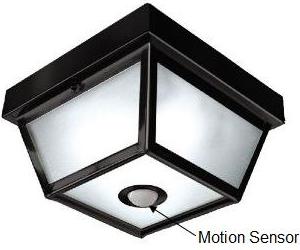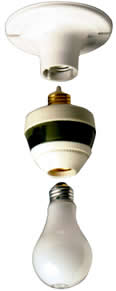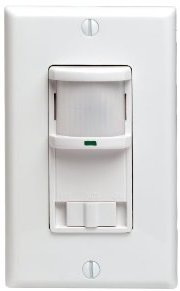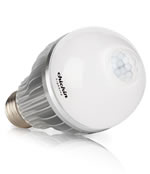Have you ever wished that a light in an attic, closet or other area would turn on automatically if a door was opened or if you entered a room?

Figure 1 - Light fixture with integral motion sensor
There are basically two methods to have a light turn on automatically.
- A occupancy sensor (motion detector),
- A door switch.
Occupancy Sensor:
The use of a occupancy sensor or motion detector sensor is the easiest installation for an automatic light.
There are many different types of motion detectors. However the types can be broken down into three categories;
- Motion detectors that are an integral part of a light fixture, as shown in Figure 1.
- Motion detectors that are separately housed but form part of the light fixture circuit, as shown in Figure 2.
- Motion detectors that replace wall switches and have an integral switch built into the mechanism, as shown in Figure 3. These types of motion detectors are often referred to as occupancy sensors.
- Now available, LED bulbs with built in motion detectors (As shown in Figure 5)
Update:

Figure 2 - Separately housed motion detector

Figure 3 - Occupancy sensor

Figure 5 - LED bulbs with built in motion detectors
Note: Light fixtures with integral motion detectors that are rated for outdoor use can be used indoors. However, light fixtures with integral motion detectors that are rated for indoor use cannot be used outdoors. The same applies to motion sensors that are not part of a light fixture. Outdoor rated motion sensors can be used indoors, but indoor rated motion sensors cannot be used outdoors.
Door Switch:
Door switches are much more difficult to install than a motion sensor and to retrofit a door switch into an existing door frame will usually require that at least one hole be made in the drywall, and in some cases multiple holes may be required in order to fish the wire from the light fixture to the door switch. The door switch is mortised into the door frame.

Figure 4 - Door switch
A door switch, as shown in Figure 4, is a switch that is automatically turned ON
and OFF
with the opening and closing of the door. It functions in the same manner as any electrical switch with the exception that instead of manually flipping a toggle to the ON
or OFF
position, the edge of the door flips the switch for you.
Door switches can be used on standard passage doors and bi-fold doors. Door switches generally do not operate well when used with pocket doors or sliding doors.
Note: Door switches are generally rated for indoor use and care should be used if you are considering installing them on exterior door frames, especially in cold climates. In many cases the door frame can reach temperatures below freezing. If you are installing a door switch on an exterior door in cold climates ensure that the door switch is rated for the maximum cold temperatures that it might be subjected too.
Door switches, installed on standard passage doors should be mounted in the door frame on the hinged side of the door. When installing door switches on bi-fold doors the door switch should be mounted on the door frame next to the point where the bi-fold door permanently pivots.
Note: The height position chosen for the installation of a door switch is completely arbitrary and the position chosen should be for convenience of installation. However, keeping the door switch above 18 inches from the floor is recommended to avoid splashing the switch with water when washing the floors.
Note: Door switches can also be installed in attic access hatches or panels and work exceptionally well in situations where the door for the attic access is hinged.
